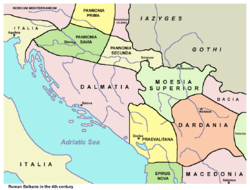![Silver coin of Roman emperor Trajan Decius (249-251 CE), with the inscription GENIVS EXERC[ITVS] ILLYRICIANI. DECIUS TRAIANUS-RIC IV 16c-190186.jpg](http://upload.wikimedia.org/wikipedia/commons/thumb/b/b2/DECIUS_TRAIANUS-RIC_IV_16c-190186.jpg/250px-DECIUS_TRAIANUS-RIC_IV_16c-190186.jpg)

The Illyrian emperors (Latin : Illyriciani) were a group of Roman emperors during the Crisis of the Third Century who were of Illyrian origin and hailed from the region of Illyria (Latin : Illyricum, in the Western Balkans), [1] [2] [3] and were raised chiefly from the ranks of the Roman army (whence they are ranked among the so-called "barracks emperors"). [1] [4] In the empire the Illyrian generals had established a powerful military caste. [5]
Contents
In the 2nd and 3rd centuries, the Illyricum, which included the provinces on the Lower Danube (Dacia, Raetia, Pannonia, Moesia), held the largest concentration of Roman forces (12 legions, up to a third of the total army), and were a major recruiting ground. The advance of these low-born provincials was facilitated by a major shift in imperial policy from the time of Gallienus (253–268) on, when higher military appointments ceased to be exclusively filled by senators. Instead, professional soldiers of humble origin who had risen through the ranks to the post of primus pilus (which also entailed admission to the equestrian order) were placed as heads of the legions and filled the army's command structure.[ citation needed ]
Decius was born in Illyricum, but he hailed from the senatorial background, for this reason the historical period of the Illyrian emperors proper begins with Claudius Gothicus in 268 and continues in 284 with the rise of Diocletian and the institution of the Tetrarchy. [6] This period was very important in the history of the Empire, since it represents the recovery from the Crisis of the Third Century, a long period of usurpations and military difficulties.
The later Valentinians (364-392 and 425–455 AD) also hailed from the Pannonia region.[ citation needed ]